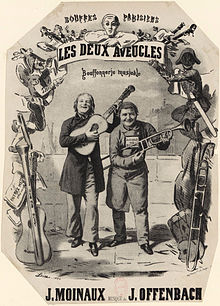Les deux aveugles

Les deux aveugles (French pronunciation: [le dø avœɡl], The Two Blind Men or The Blind Beggars) is an 1855 one-act French bouffonerie musicale (operetta) by Jacques Offenbach.[1] The libretto was written by Jules Moinaux and was a condensation of his 3-act Les musiciens ambulants.[2]
The half-hour long piece is a comic sketch about two (supposedly) blind beggars, consisting of an overture and four numbers. Offenbach was bold in making light of the disabled poor, but he believed that his patrons would see the humour of the piece. Most Parisians had been pestered by beggars on Parisian street corners, and Offenbach's blind beggars were con men, rather than deserving outcasts of society. The little piece was an instant hit, praised for its catchy dance tunes, and it soon spread Offenbach's name and music around the world.
Performance history

Les deux aveugles premiered on the opening night of the
The piece was first seen in Berlin at
Les deux aveugles was translated into German by Carl Friedrich Wittmann as Zwei arme Blinde and was performed in Vienna at the
Arthur Sullivan saw the piece performed by the amateur "Moray Minstrels" group in London and was prompted to collaborate with F. C. Burnand on the first of his many operettas, Cox and Box (1866). In its use of the voice imitating a musical instrument and the combination together of separate melodies (though done previously by Sullivan), Offenbach's work points towards features of the one-act Sullivan piece, with which it shared an evening.[11]
A complete performance of Les deux aveugles (followed by Croquefer, ou Le dernier des paladins) forms part of the 1996 television film Offenbachs Geheimnis, directed by István Szabó.[12]
The work was presented by Palazzetto Bru Zane on a double bill with Le compositeur toqué by Hervé at the Théâtre Marigny, Paris, for a series of performances beginning in January 2019.[13]
Subsequent works
With Les deux aveugles Offenbach became the darling of Second Empire Paris. His later pieces would continue to mock customs of the day, without really upsetting the status quo enjoyed by the theatre-going public. Offenbach's early operettas were small-scale one-act works, since the law in France limited musical theatre works (at all except the principal theatres) to one-act pieces with no more than three singers and, perhaps, some mute characters.[14]
In 1858, this law was changed, and Offenbach was able to offer full-length works, beginning with Orpheus in the Underworld.
Roles

| Role | Voice type | Premiere cast,[6] 5 July 1855 (Conductor: Jacques Offenbach) |
Revised version,[6] 28 May 1858 (Conductor: Giannini) |
|---|---|---|---|
| Giraffier | tenor | Jean-François Berthelier | Jean-François Berthelier |
| Patachon | tenor | Étienne Pradeau [fr][15] | Charles-Louis Sainte-Foy |
Synopsis
- Time: 19th century
- Place: Paris
Two "blind" beggars compete for the best position on a bridge, first in a musical battle with Patachon playing on a trombone and Giraffier a mandolin, then in a game of cards, in which they cheat and betray their pretense of blindness. 'Business' has not been brisk. When passers-by drop coins, the beggars are able to see well enough to retrieve them. To impress each other, they fabricate wild stories, accompanied by singing. The contest becomes comically grotesque.
Music
The music consists of an overture and four short numbers, of which the bolero, a duet which begins "La lune brille, le ciel scintille" ("The moon beams, the sky sparkles"), is probably the standout.[1]
References
Notes
- ^ a b Lamb 1992, p. 1143.
- ^ Teneo 1920, p. 103.
- ^ Harding 1980, pp. 66–67.
- ^ Yon 2000, p. 171.
- ^ Letellier 2010, p. 586; Wild & Charlton 2005, p. 214; Wolff 1953, p. 58.
- ^ a b c d Wolff 1953, p. 58.
- ^ a b c d e f g Loewenberg 1978, columns 918–919.
- ^ Gänzl 2001, "Treumann, Karl" p. 2071.
- ^ a b c d e Gänzl 2001, "Les deux aveugles" p. 501.
- ^ Gänzl 2001, "Sullivan" p. 1966.
- ^ Jacobs, Arthur. Arthur Sullivan, a Victorian Musician. Scolar Press, Aldershot, 1992, p. 51.
- ^ BFI database, accessed 3 April 2013.
- ^ Kamer, Waldemar (22 January 2019). "PARIS / Théatre Marigny LES DEUX AVEUGLES von Jacques Offenbach". Online Merker (in German). Retrieved 22 January 2019.
- ^ Background on Offenbach on musicals101.com/operetta Retrieved 20 August 2012
- ^ Gänzl 2001, "Pradeau" p. 1645.
Sources
- ISBN 978-0-02-864970-2.
- ISBN 9780714538419
- Lamb, Andrew(1992). "Les deux aveugles" in Sadie 1992, vol. 1, p. 1143.
- ISBN 978-1-4438-2140-7.
- Loewenberg, Alfred (1978). Annals of Opera 1597–1940 (third edition, revised). Totowa, New Jersey: Rowman and Littlefield. ISBN 978-0-87471-851-5.
- ISBN 978-1-56159-228-9.
- Teneo, Martial (1920). "Jacques Offenbach : His Centenary", translated by Theodore Baker, in The Musical Quarterly, vol. 6, no. 1 (January 1920), pp. 98–117.
- ISBN 978-2-87009-898-1.
- Wolff, Stéphane (1953). Un demi-siècle d'Opéra-Comique (1900-1950). Paris: André Bonne.
- Yon, Jean-Claude (2000). Jacques Offenbach. [Paris]: Galimard. ISBN 978-2-07-074775-7.
External links
- Recordings may be found on operadis-opera-discography.org.uk
- Libretto as submitted for censorship, Paris 1855
- Les deux aveugles: Scores at the International Music Score Library Project
- American Symphony.org article discussing Offenbach's operettas at the Wayback Machine (archived September 27, 2007)
- Boosey and Hawkes website information, accessed 25 May 2010
